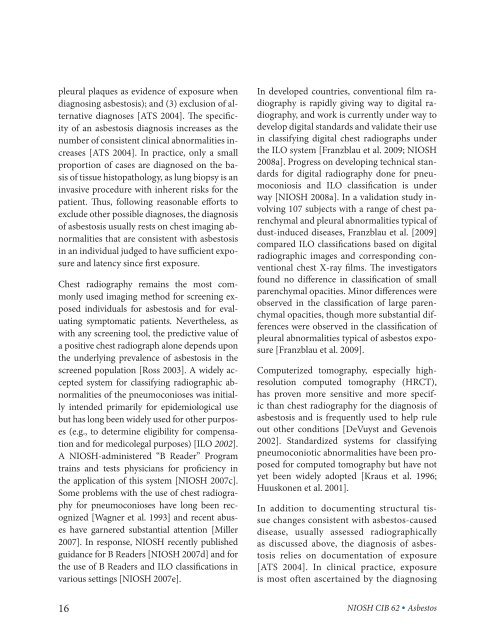Asbestos Fibers and Other Elongate Mineral Particles: State of the ...
Asbestos Fibers and Other Elongate Mineral Particles: State of the ...
Asbestos Fibers and Other Elongate Mineral Particles: State of the ...
- No tags were found...
Create successful ePaper yourself
Turn your PDF publications into a flip-book with our unique Google optimized e-Paper software.
pleural plaques as evidence <strong>of</strong> exposure when<br />
diagnosing asbestosis); <strong>and</strong> (3) exclusion <strong>of</strong> alternative<br />
diagnoses [ATS 2004]. The specificity<br />
<strong>of</strong> an asbestosis diagnosis increases as <strong>the</strong><br />
number <strong>of</strong> consistent clinical abnormalities increases<br />
[ATS 2004]. In practice, only a small<br />
proportion <strong>of</strong> cases are diagnosed on <strong>the</strong> basis<br />
<strong>of</strong> tissue histopathology, as lung biopsy is an<br />
invasive procedure with inherent risks for <strong>the</strong><br />
patient. Thus, following reasonable efforts to<br />
exclude o<strong>the</strong>r possible diagnoses, <strong>the</strong> diagnosis<br />
<strong>of</strong> asbestosis usually rests on chest imaging abnormalities<br />
that are consistent with asbestosis<br />
in an individual judged to have sufficient exposure<br />
<strong>and</strong> latency since first exposure.<br />
Chest radiography remains <strong>the</strong> most commonly<br />
used imaging method for screening exposed<br />
individuals for asbestosis <strong>and</strong> for evaluating<br />
symptomatic patients. Never<strong>the</strong>less, as<br />
with any screening tool, <strong>the</strong> predictive value <strong>of</strong><br />
a positive chest radiograph alone depends upon<br />
<strong>the</strong> underlying prevalence <strong>of</strong> asbestosis in <strong>the</strong><br />
screened population [Ross 2003]. A widely accepted<br />
system for classifying radiographic abnormalities<br />
<strong>of</strong> <strong>the</strong> pneumoconioses was initially<br />
intended primarily for epidemiological use<br />
but has long been widely used for o<strong>the</strong>r purposes<br />
(e.g., to determine eligibility for compensation<br />
<strong>and</strong> for medicolegal purposes) [ILO 2002].<br />
A NIOSH-administered “B Reader” Program<br />
trains <strong>and</strong> tests physicians for pr<strong>of</strong>iciency in<br />
<strong>the</strong> application <strong>of</strong> this system [NIOSH 2007c].<br />
Some problems with <strong>the</strong> use <strong>of</strong> chest radiography<br />
for pneumoconioses have long been recognized<br />
[Wagner et al. 1993] <strong>and</strong> recent abuses<br />
have garnered substantial attention [Miller<br />
2007]. In response, NIOSH recently published<br />
guidance for B Readers [NIOSH 2007d] <strong>and</strong> for<br />
<strong>the</strong> use <strong>of</strong> B Readers <strong>and</strong> ILO classifications in<br />
various settings [NIOSH 2007e].<br />
16<br />
In developed countries, conventional film radiography<br />
is rapidly giving way to digital radiography,<br />
<strong>and</strong> work is currently under way to<br />
develop digital st<strong>and</strong>ards <strong>and</strong> validate <strong>the</strong>ir use<br />
in classifying digital chest radiographs under<br />
<strong>the</strong> ILO system [Franzblau et al. 2009; NIOSH<br />
2008a]. Progress on developing technical st<strong>and</strong>ards<br />
for digital radiography done for pneumoconiosis<br />
<strong>and</strong> ILO classification is under<br />
way [NIOSH 2008a]. In a validation study involving<br />
107 subjects with a range <strong>of</strong> chest parenchymal<br />
<strong>and</strong> pleural abnormalities typical <strong>of</strong><br />
dust-induced diseases, Franzblau et al. [2009]<br />
compared ILO classifications based on digital<br />
radiographic images <strong>and</strong> corresponding conventional<br />
chest X-ray films. The investigators<br />
found no difference in classification <strong>of</strong> small<br />
parenchymal opacities. Minor differences were<br />
observed in <strong>the</strong> classification <strong>of</strong> large parenchymal<br />
opacities, though more substantial differences<br />
were observed in <strong>the</strong> classification <strong>of</strong><br />
pleural abnormalities typical <strong>of</strong> asbestos exposure<br />
[Franzblau et al. 2009].<br />
Computerized tomography, especially highresolution<br />
computed tomography (HRCT),<br />
has proven more sensitive <strong>and</strong> more specific<br />
than chest radiography for <strong>the</strong> diagnosis <strong>of</strong><br />
asbestosis <strong>and</strong> is frequently used to help rule<br />
out o<strong>the</strong>r conditions [DeVuyst <strong>and</strong> Gevenois<br />
2002]. St<strong>and</strong>ardized systems for classifying<br />
pneumoconiotic abnormalities have been proposed<br />
for computed tomography but have not<br />
yet been widely adopted [Kraus et al. 1996;<br />
Huuskonen et al. 2001].<br />
In addition to documenting structural tissue<br />
changes consistent with asbestos-caused<br />
disease, usually assessed radiographically<br />
as discussed above, <strong>the</strong> diagnosis <strong>of</strong> asbestosis<br />
relies on documentation <strong>of</strong> exposure<br />
[ATS 2004]. In clinical practice, exposure<br />
is most <strong>of</strong>ten ascertained by <strong>the</strong> diagnosing<br />
NIOSH CIB 62 • <strong>Asbestos</strong>

















